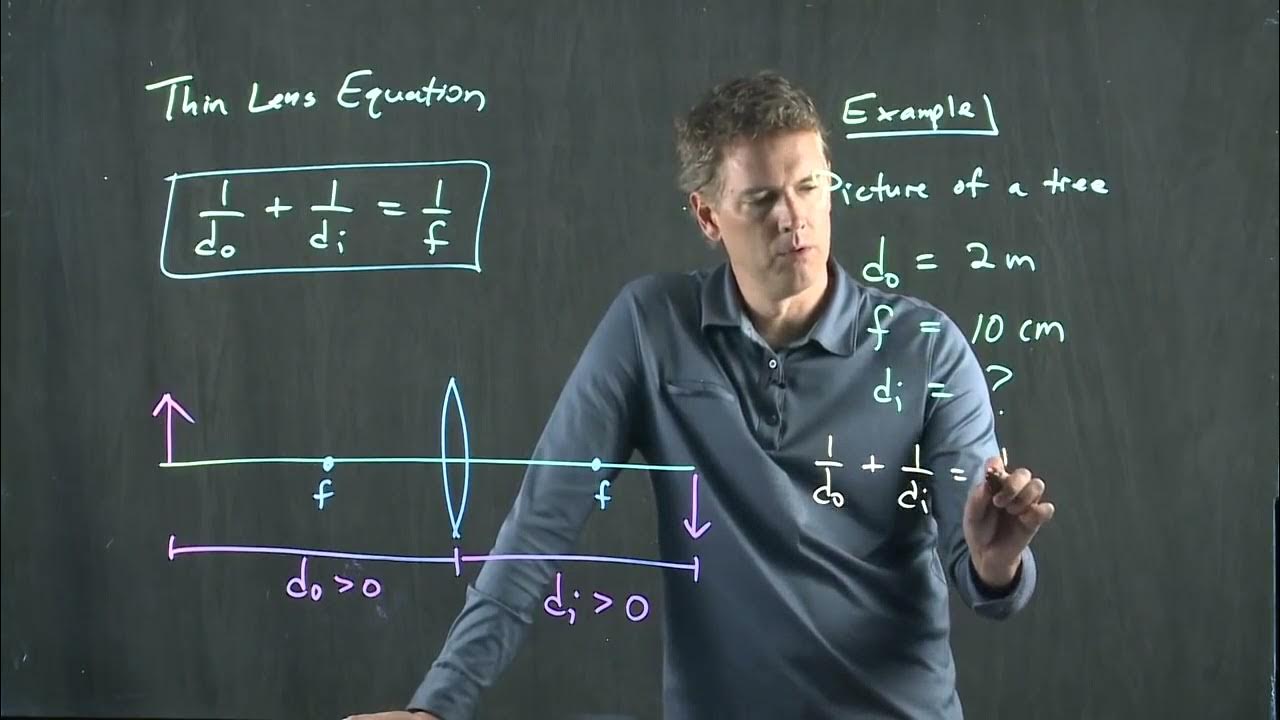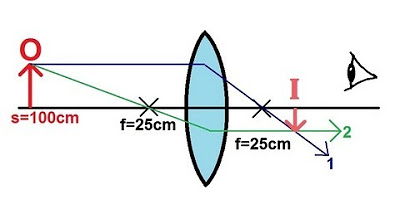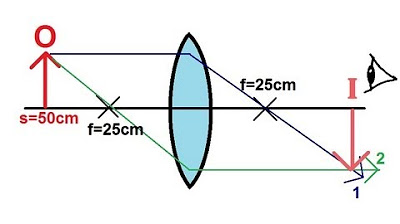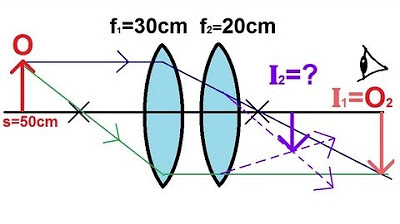The Camera | Physics with Professor Matt Anderson | M28-20
TLDRIn this lesson, the instructor explains a problem involving a film camera lens with a focal length of 40 millimeters. The task is to determine how the distance between the lens and the film should be adjusted to change the focus from an object 25 meters away to one 4 meters away. The solution involves applying lens formulas to calculate image distances and the necessary adjustment, ultimately finding that the lens position only needs to change by a small fraction of a millimeter. The instructor emphasizes the precision and relevance of these calculations in real-world scenarios, such as smartphone cameras.
Takeaways
- 📷 The script discusses a problem related to a camera's lens system, specifically focusing on how to adjust the distance between the lens and the film to change focus from a distant to a closer subject.
- 🔍 The focal length of the lens in the camera is given as 40 millimeters, which is a key parameter in determining the image distance for objects at different distances.
- 📏 The initial object distance from the lens is 25 meters, and the goal is to find the new image distance when the object is moved to 4 meters away.
- 🧮 The lens formula \( \frac{1}{f} = \frac{1}{d_o} + \frac{1}{d_i} \) is used to calculate the image distance for the given focal length and object distance.
- ✂️ The image distance is calculated to be approximately 40 millimeters for the initial setup with the object at 25 meters away.
- 🔄 When the object is moved closer to 4 meters, the image will move further away from the lens according to the lens rules.
- 📐 The new image distance is recalculated using the updated object distance, with the focal length remaining constant at 40 millimeters.
- 🔢 The calculation for the new image distance results in a small adjustment from the initial image distance, indicating a minor change in lens position is needed.
- 📉 The difference in image distance, Δd_i, between the two scenarios is calculated to be 0.0004 meters or 0.4 millimeters, a very small adjustment.
- 📱 The script highlights the practical application of these principles in modern cameras, such as smartphone cameras, which can focus on objects at varying distances with minimal physical lens movement.
- 🤔 The importance of precision in calculations is emphasized, as even small differences in image distance can significantly affect the focus of the camera.
Q & A
What is the focal length of the lens in the camera discussed in the script?
-The focal length of the lens in the camera discussed in the script is 40 millimeters.
What is the initial distance of the person from the lens before adjusting the focus?
-The initial distance of the person from the lens is 25 meters.
What is the new distance of the person from the lens after the focus adjustment?
-The new distance of the person from the lens after the focus adjustment is 4 meters.
What is the formula used to calculate the image distance (di) in the context of the lens formula?
-The formula used to calculate the image distance (di) is 1/di = 1/f - 1/do, where f is the focal length and do is the object distance.
What is the calculated initial image distance (di) when the person is 25 meters away?
-The calculated initial image distance (di) when the person is 25 meters away is approximately 0.0404 meters or 40.4 millimeters.
How does the image distance change when the object is moved from 25 meters to 4 meters away?
-The image distance increases slightly when the object is moved from 25 meters to 4 meters away due to the lens rules.
What is the amount by which the distance between the lens and the film needs to be adjusted to change focus from 25 meters to 4 meters?
-The distance between the lens and the film needs to be increased by approximately 0.0004 meters or 0.4 millimeters to change focus from 25 meters to 4 meters.
Why is it necessary to adjust the lens position when changing the focus from a distant object to a closer one?
-Adjusting the lens position is necessary to ensure that the image remains in focus on the film plane as the object distance changes.
How does the script illustrate the practical application of lens focusing in a camera?
-The script illustrates the practical application of lens focusing by showing the mathematical calculation required to adjust the lens position for different object distances, which is crucial for clear imaging.
What is the significance of the small adjustment needed in a smartphone camera to focus on objects at different distances?
-The small adjustment needed in a smartphone camera signifies the advanced technology that allows for a wide range of focus without significant lens movement, due to the thin form factor of smartphones.
Why is it important to keep all the digits when calculating the change in image distance (delta di)?
-Keeping all the digits is important because the initial and new image distances are very close to each other, and even a small change can significantly affect the focus, as demonstrated by the 0.4 millimeters adjustment.
Outlines
📷 Camera Lens Focus Adjustment
The script begins with a decision to skip diffraction problems and move on to a question about adjusting a camera's focus. It involves a simple film camera with a 40-millimeter focal length lens. The task is to determine how much the distance between the lens and the film should be changed to shift the focus from a person 25 meters away to one who is 4 meters away. The presenter suggests using the lens formula to calculate the initial image distance when the object is 25 meters away, which is found to be approximately 40 millimeters, slightly larger than the focal length.
🔍 Calculating Image Distance for Closer Object
Continuing from the previous scenario, the script discusses the need to recalculate the image distance when the object is moved to 4 meters from the lens. The focal length remains constant at 40 millimeters. The presenter explains that the image will move further away from the lens when the object is closer, thus requiring the lens to be moved away from the film plane. The calculation is performed using the lens formula, and it is found that the new image distance is very close to the initial one, differing by a small amount of 0.4 millimeters. This highlights the precision required in adjusting camera focus and the capability of modern cameras, such as those in smartphones, to adjust focus over a wide range without significant lens movement.
Mindmap
Keywords
💡Diffraction
💡Focal Length
💡Lens
💡Film Camera
💡Image Distance
💡Lens Rules
💡Object Distance
💡Calculator
💡Smartphone Camera
💡Selfie
💡Optics
Highlights
Skipping number seven due to sufficient coverage on diffraction problems.
Moving on to number ten, a question about adjusting camera focus for different object distances.
Introduction of a simple film camera with a 40mm focal length lens.
Explanation of changing focus from a person 25 meters away to one 4 meters away.
Drawing a simple diagram to visualize the camera system.
Using lens rules to determine the image distance for an object 25 meters away.
Calculation of image distance using the lens formula 1/f = 1/do + 1/di.
Conversion of units to meters for consistency in calculations.
Initial calculation of image distance di, resulting in approximately 40 millimeters.
Discussion on the expected range of di in relation to the focal length f.
Adjusting the object distance to 4 meters and recalculating the new image distance.
Understanding that the image would move further away from the focus with a closer object.
Recalculating di with the new object distance using the lens formula.
Realization of the small adjustment needed in the lens position for the new object distance.
Final calculation resulting in a 0.4-millimeter adjustment for the lens position.
Implication of the small adjustment for practical use in cameras, including smartphone cameras.
Confirmation of the camera's ability to focus on objects at varying distances with minimal lens movement.
Transcripts
Browse More Related Video

Picture of a Tree - Thin Lens Equation | Physics with Professor Matt Anderson | M27-18

Wearing Glasses - What's the Power? | Physics with Professor Matt Anderson | M28-03

Physics - Optics: Lenses (1 of 4) Converging Lens

Physics - Optics: Lenses (2 of 4) Converging Lens

Physics - Optics: Lenses (1 of 5) Lens Combinations - Two Converging Lenses

Physics - Optics: Lenses (3 of 4) Converging Lens
5.0 / 5 (0 votes)
Thanks for rating: